Do you want to learn how to train a sugar glider?
You’ve come to the right place.
These adorable creatures are wild animals – and if you don’t start training them & bonding with them at an early age, it will be much harder to do it later.
Please keep reading to find out how to bond with your sugar glider, potty-train them and even how to teach them some new tricks.
Table of Contents
How To Train a Sugar Glider
Let’s start with bonding with your glider, since that sets the groundwork for all other types of training.
1. How To Bond With Your Sugar Glider
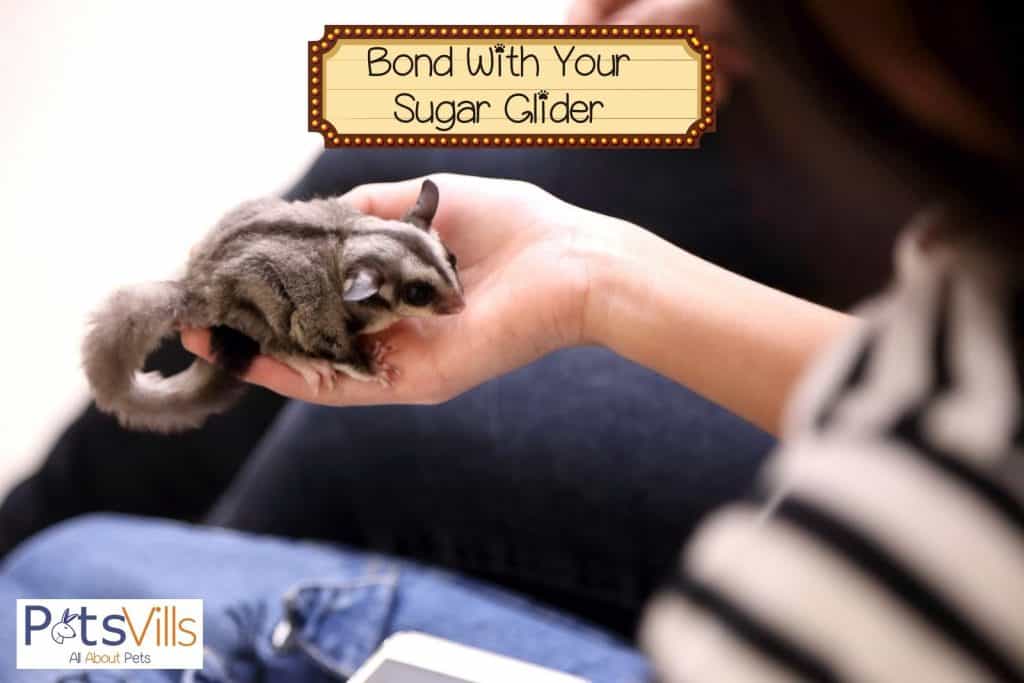
Below are some great tips that will make your sugar bear want to spend more time with you.
Let Your Glider Adjust To Your Home First
Before you begin training, you need to make sure your sugar glider is comfortable at your home.
After adoption, give her at least 2 to 3 days to familiarize herself with the place. Also, try to arrange her homecoming for a time when you have a few days off work.
You can also use treats such as yogurt, applesauce, or baby food to entice her. Place these sugar glider treats on your finger and let her come to you.
They’ll not do it on the first day, but eventually, they come around.
At this stage, you can try and talk to her in a soft voice to show her that you’re not a threat.
Go near- but not up against- the habitat and speak in a calm voice.
Try reading a children’s book or humming a favorite song. Whatever you do, just sit there and make sure they can see you.
But it’s not a good idea to pick her up since she has not bonded with you yet and may react by biting.
RECOMMENDED ARTICLE: What is the Lifespan of a Sugar Glider?
Let Her Get to Know Your Scent
One of the ways pets recognize their owners is through their scent. You can wear a piece of cloth and then leave it in her cage.
This gives her the chance to associate the scent with you and get used to having it around.
At this point, you should avoid changing your cologne, perfume, or shampoo. All this does is confuse your sugar gliders, and if they can’t recognize you the next time you come to see them, you’ll be back to square one in the bonding process.
You can also place towels or fleece that smells like you in the bonding pouch when they’re not in it.
As they get used to your scent, they’ll feel some comfort every time they’re close to you.
Sit With Your Sugar Glider In A Small Room
Choose a small room, preferably a bathroom, and lock all the places your sugar glider may escape through.
Then, bring your pet into the room while she’s still in the pouch.
The goal here is to spend some quality time with your pet (at least an hour) so that she gets used to having you around.
Make sure this room is free from objects that may hurt your pet. Please ensure the toilet lid is closed since she may jump into the toilet bowl as she escapes and drown.
And if you have other pets, such as dogs or cats, don’t let them into the room.
All you have to do is open the pouch, place some treats at the opening to entice her to come out, and sit there and watch her.
Once you’re done, allow her to get back into the pouch. If she won’t do it, you can place treats in the pouch. Create a routine for this activity for a couple of nights.
Use A Bonding Pouch
Another way to make the sugar glider get used to being close to you is to wear the bonding pouch.
These are the pouches that gliders sleep in, and they’ll often have strings or shoulder straps. You can wear it for most of the day.
If they’re crabbing (a noise they make when scared) or lunging in the bonding bag, rub them gently, hold them close to your chest, or even hum a tune to calm them down.
Once you’re done, you can place them back into the cage. You may realize that your pets may still get aggressive when in the bonding pouch.
This is because the pouch is enclosed, and they may not see you coming. Or they’re freak out every time you take a peek at them when they’re in the pouch.
You can solve this by getting an open environment sugar glider pouches (such as this one) so that even though they’re in the pouch, they can still see you coming and even associate you with your voice.
Check out the video below for an example of crabbing:
React to Biting the Right Way
Is a sugar glider bite dangerous?
Biting is one of their defense mechanisms. So don’t be surprised when they bite you during the first few days of bonding.
The best thing to do once they bit is to keep petting and bonding with them.
If you walk away as soon as they bite, you’re showing them that you are actually a threat, and biting you is the best way to get rid of you.
Use Treats
It’s not always easy to train sugar gliders not to bite, especially when dealing with “teenagers.”
The best you can do is distract them with treats every time they try to bite.
You can also discourage them by gently blowing some air on the back of their heads.
Most sugar gliders hate that feeling. When offering treats, you can also touch your pet’s tail.
By now, she’s already used to having you around, but she can’t stay on you (which is one of the reasons people on this pet) if they can’t stand you touching them.
Create a routine
Once you have bonded with your pet, you can form a routine activity that you’ll be doing with her daily.
This could be tent time with your pet, spending some time in the bathtub (with no water, of course) where you allow her to walk on to you, or wearing the bonding pouch at the same time every day for the same amount of time.
To keep them close to you when bonding, Kimberly on the video below found that bra bonding pouches were very useful.
But if a bra pouch is not an option, you can pet them when they’re still in the zippered bonding bag.
You can also train them to climb and stay on you, as I’m going to discuss in the next section.
2. How To Train A Sugar Glider To Stay On You
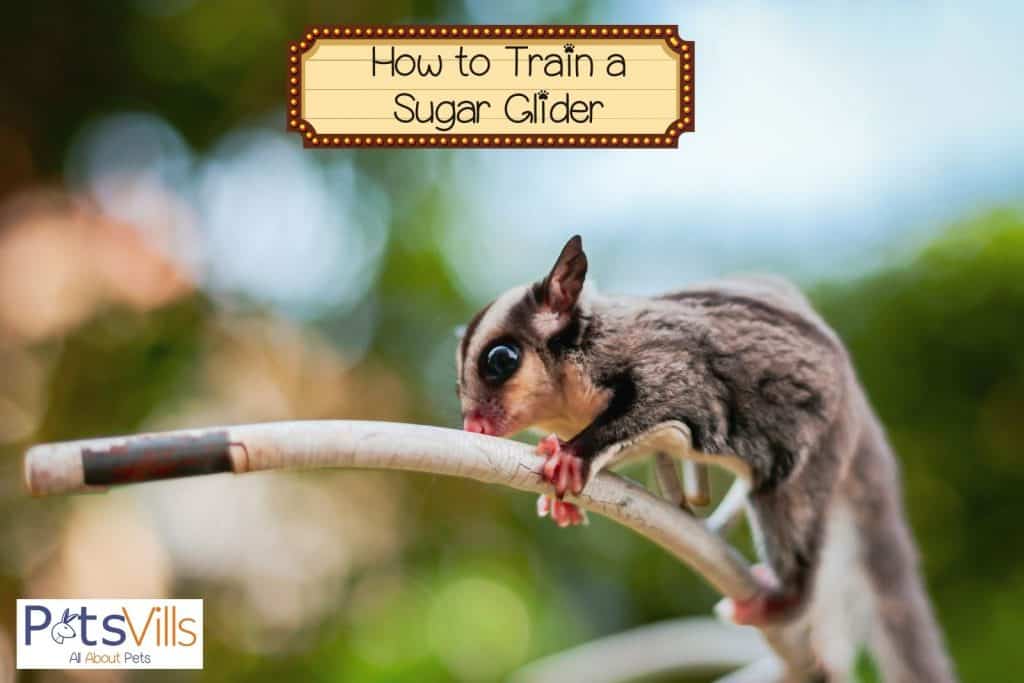
Having a sugar glider stay on you is one of the best experiences. I mean, you don’t expect them to spend all their time in the cage or the pouch.
Below are some tips to get your gliders to climb on you and stay there.
Start with a small and safe room.
The smaller the room, the better. This ensures the sugar glider is close to you at all times and is not tempted to jump off to other areas.
Make sure the room is safe and block all the spaces your pet can’t escape through.
Bring your pet into the room.
Sugar gliders spend most of their time in the pouch. So bring the pet while she’s in the bag into the room.
Next, entice her to get off the pouch. You can use treats or even call her out. Sugar gliders are nocturnal, so they’ll most probably respond better to training at night.
Keep the glider on you at all times.
There are times when the sugar glider will want to jump off from you onto the floor. When she does that, pick her up immediately and place her back on you.
This will show her that it’s best to stay on you. Another way to do this is to train them that the only time they get to jump is when they’re jumping onto the cage.
When you’re getting the pet from the cage, let her climb on you. And then move away from the cage.
You should also “define” which parts of the body they should be on most of the time, which is mostly your chest, shoulder, head, or arms.
Prevent them from going to your back. If they do, you can slowly move back towards the wall, and they’ll have no choice but to climb to your shoulders.
If they go to your back, don’t rush your hands to grab them since they may bite. Gently encourage them to move to your arms or shoulders.
Move to a larger room.
Once you manage to keep the pet on you, you can move to a larger room. Ensure the room is safe by removing objects she could jump to and hurt herself.
As I mentioned earlier, if there are other pets in your house, lock them in another room when training.
Always be on the move.
Another way to keep the sugar glider on you is to keep moving. By this time you’ve moved to a larger room. So you can move around in the room, or even move around your house.
Prevent them from targeting
Sugar gliders are known for jumping from tree to tree by “gliding” through the air. They do the same in your house when they jump off objects.
What you may not know is that they actually scan for the best place to land before they can jump.
As long as they’re on your arms or shoulder, you can see them targeting.
What you need to do is block them by placing your arm in front of their eyes. If they can’t see the target, they can’t jump.
3. Bathroom Training A Sugar Glider
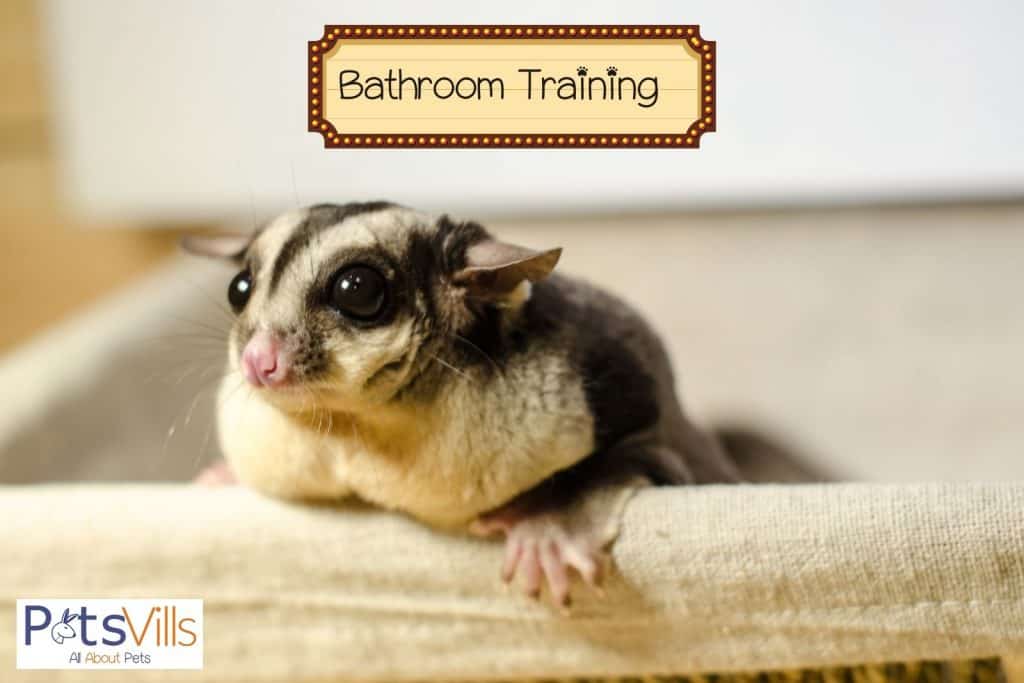
I hate to break it to you, but litter box training is not straightforward for sugar gliders.
But their bathroom schedules are very predictable, and once you learn them, you can always know when they need to poo.
Just like people, sugar gliders often go to the bathroom as soon as they wake up. This could be in the morning (since they’re nocturnal, their morning time is our nighttime).
In most cases, they’ll also want to go to the bathroom when you wake them up during the day for bonding time.
As soon as your pet wakes up, hold her over some paper towels. This will stimulate her to go to the bathroom on the paper towels.
Use unscented baby wipes to wipe the private area until she releases all the urine and feces. Another way to stimulate your pet to go to the bathroom is to keep her moving.
Place some baby wet pipes on both of your hands and create a “treadmill,” where you move the glider from one hand to another.
Once you’re confident she’s done, use the baby wipes to help her finish up.
Sugar gliders take 5 to 7 minutes to empty the urine and feces, and you’ll have at least 2 to 4 hours before you have to go through this process again.
If she starts moving around in your pocket, then she needs to go to the bathroom.
Get her out of the pouch, and use the treadmill and wiping technique to help her empty all the contents. For very small animals, they sure do poop a lot.
But each sugar glider has its own capacity. Eventually, you’ll learn her capacity, her habit, and the best way to help her go to the bathroom.
Potty Training
I know I said it might be impossible, but it’s worth a try. Below are some steps;
- Place a litter box on one of the corners and place some of the sugar glider’s feces in it.
- Every time your pet uses the litter box, reward it with a treat.
- If she drops the feces on the flow of the cage, pick it up and pace it in the litter box.
- Use paper pulp, shredded paper, or grass pellets as litter. Avoid using cat litter since they may eat it.
4. Teaching Your Sugar Glider Tricks
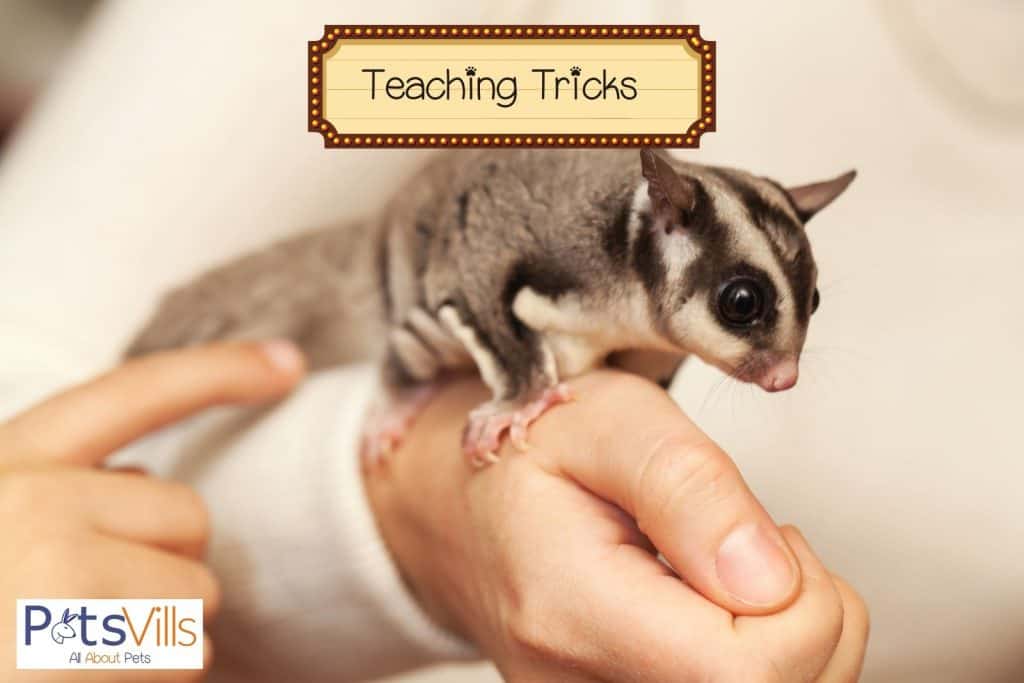
Once you have fully bonded with your pet, you can start training them how to come when called, how to jump, or any other tricks you may have in mind.
Get A Clicker
Clicker training is one of the most effective methods of training pets, including sugar gliders.
The clickers make a clicking sound that lets the pet know whatever they’re doing is okay.
You can order clickers (such as this one) for less than $10 or a clicking ballpoint pen.
Choose a small room
Choose a small room to make sure the sugar glider is not distracted.
As mentioned earlier, you can use your bathroom or the bathtub, but make sure the toilet lids are closed, and the drains are plugged.
A non-slip mat will also make the bathroom floors safe for you and your pet.
Once you get the pet in the room, allow how to explore the room until they’re interested in what you’re doing.
Associate the click with a treat
Make clicking sounds with the clicker, and offer a treat at the same time. Eventually, they’ll learn that something good always follows a treat.
They will even look forward to it every time you make a clicking noise. Some of the goodies you can offer your pet include dried vegetables and fruits, cheerios, dried meat, or yogurt.
Train The Sugar Glider to Come To You
Since you’re the only one in the room, your sugar glider will eventually turn her attention towards you.
Once she does, make a trail of treats towards you while clicking every time you want to place the treat.
At this point, you can even use command words such as “come.” Use the same cue words over and over to make sure she understands it.
Teach your sugar glider to touch stuff
Place a ball at one place in the room, and click and treat every time your sugar glider moves towards the ball.
Repeat the process, and when she gets used to it, take it a notch higher by clicking and treating only when she touches the ball.
You can also use words such as touch to draw her attention towards the ball.
Teach Your Sugar Glider Hoop Jumping
Hold a hoop in front of your pet, and click and treat every time she moves towards the hoop and jumps to the other side.
Once she gets it, lift the hoop higher, and use words such as “jump.”
Teach Your Sugar Glider to Jump
If you’d like to see the gliding in action, you can place the sugar glider on a shelf and hold a treat in your hand.
Call out to her while making a clicking sound, and she’ll jump onto your hand.
At this point, you’ll have taught her command words such as “jump,” and this will show that she can respond to them.
Check the amazing video below.
5. Be Patient and Consistent
Sugar gliders aren’t the easiest pets to train. So, be patient if they don’t seem to learn a trick or bond with you the first time.
Be consistent in your routine, repeat the same training techniques repeatedly, and don’t be afraid to back to square one.
You can use clicker training to teach them any trick, including things that they already do but want them to do on command.
Just follow the click and treat method to engage them.
A few extra tips;
Try group training
It’s easier to train sugar gliders as a group.
They enjoy when there are other sugar gliders around, and your bonding techniques will be more effective.
According to World Animal Protection, sugar gliders are very social animals, and they thrive in groups when in the wild.
However, be careful when placing them together since sometimes they’ll bond with each other and see you as a threat.
Never punish!
Don’t lash out at your sugar gliders or punish them if they bite or don’t follow instructions.
They don’t understand negative reinforcement, and it will be more challenging to tame them after that.
Consider their personalities
Sugar gliders have different personalities.
Taming them involves understanding their personalities, what they like (treats and handling technique), and what they don’t like.
How To Train A Sugar Glider FAQs
Are Sugar Gliders Easy To Train?
When compared to dogs or cats, it’s much more challenging to tame a sugar glider. But with the proper bonding techniques, you can get them to trust you enough, making it possible to teach them other tricks.
How Long Does It Take To Train A Sugar Glider?
Training/taming a sugar glider can take days or weeks depending on how much time you spend with them each day, their age, and what you’re trying to teach them.
Can you domesticate sugar gliders?
Sugar gliders are wild animals, so domesticating is an overstatement. Sure, you can tame them and teach them a few tricks, but their habits, diet needs, habitat needs, and health needs are similar to those in the wild.
Conclusion
And there you have it. You can tame a sugar glider of any age.
The first step is learning how to introduce sugar gliders to your scent, voice, and get used to having you around.
Remember, just because they looked sociable with the breeder doesn’t mean they’ll be all over you when you get home.
Once you have bonded with your pet, you can start training them tricks using positive reinforcement.
Patience and consistency are key when taming sugar gliders. You’ll realize that you have to do the same things over and over even when they’ve mastered the trick.
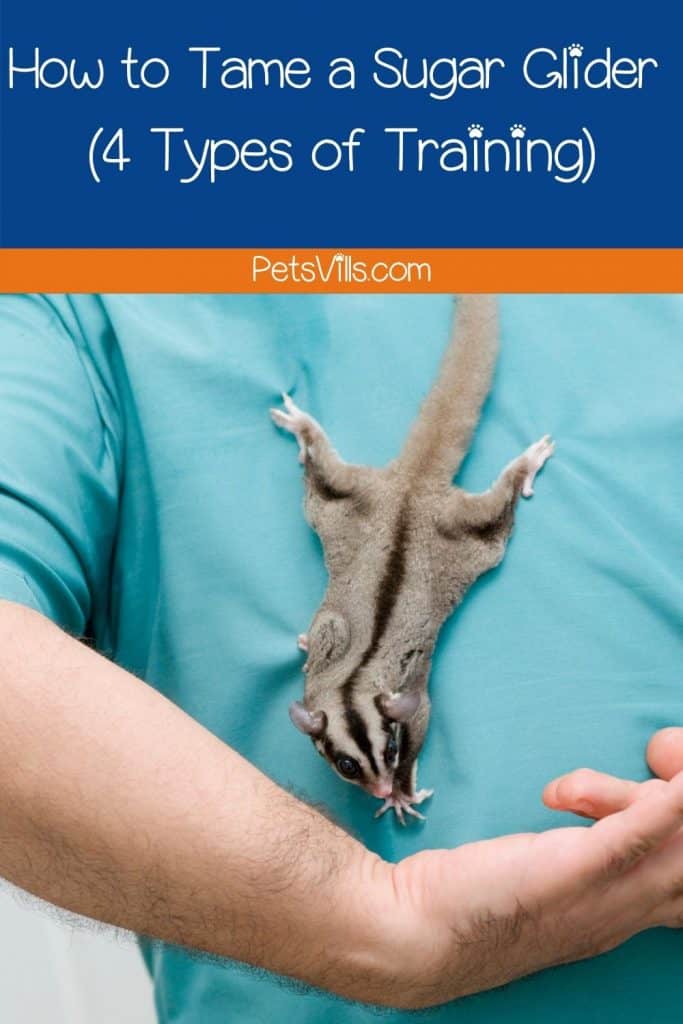
Do you have other tips on how to train a sugar glider? Share with us below!
Barry Stingmore is a British content writer living in Fuerteventura, Spain. An animal lover at heart, he shares his home with a dog and four rescue cats and has a passion for writing about animals big and small.
Barry loves finding answers to your animal-related questions, the more research involved the better! You can rely on him to find the facts.
Find him on FACEBOOK, TWITTER AND Linkedin
Read his latest ARTICLES.
Find more about him HERE.

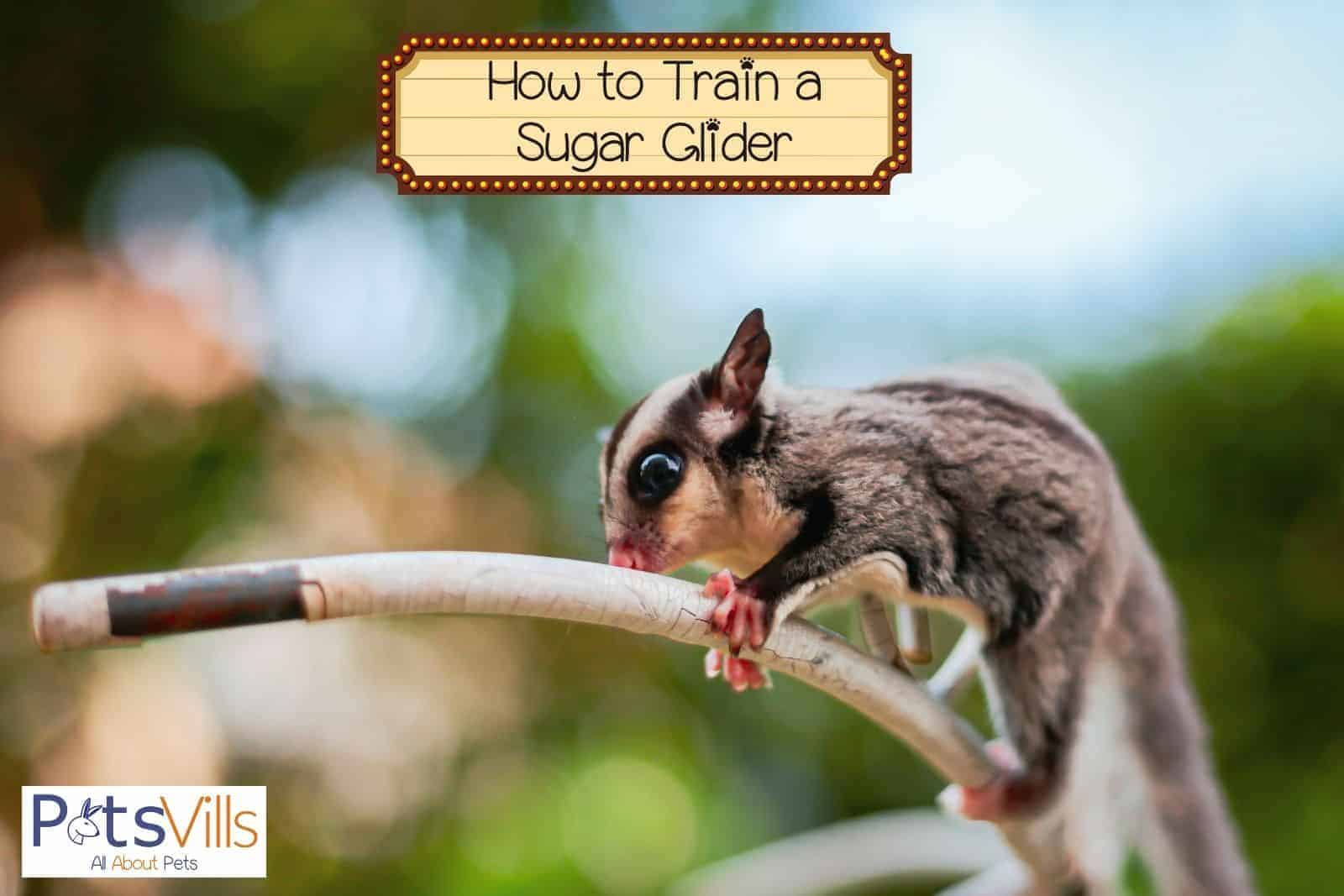


![Cute Sugar Glider Drinking From The Bottle [Must-Watch Video]](https://petsvills.com/wp-content/uploads/2022/09/Cute-Sugar-Glider-Drinking-From-The-Bottle-Must-Watch-Video-211x150.jpg)
